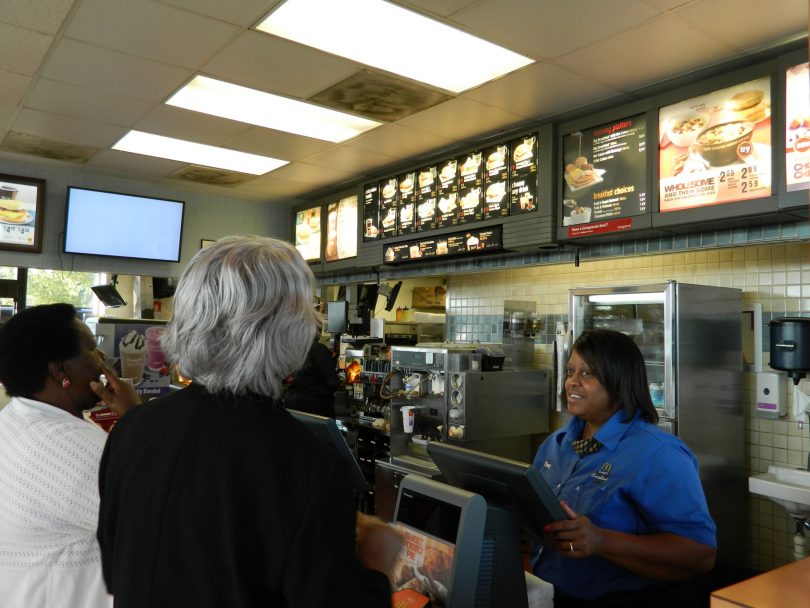Written by Heather McGinley
Hundreds of dine-in and drive-through customers by now have seen the menu-boards at area McDonald’s featuring each item’s calorie count. Less apparent is that the new signage is part of a larger restaurant initiative to encourage better health.
By the end of 2013, regulation will require all restaurants nationally to post calorie information in their stores, explains Shaye Arluk MS, RD, HFI and McDonald’s Nutritional Consultant for the region. In September, McDonald’s became the first quick service restaurant to have posted calorie content in all of its stores and drive-thrus. Posting calorie information this way was always been part of the plan for McDonald’s, Arluk says.
McDonald’s “Balanced Active Lifestyle Commitment” and other more recent commitments have prompted several changes over the last seven years, she says. The most recent commitment goals focus on children’s well-being, expanding nutritionally balanced menu items and providing nutrition information and education for customers and employees.
McDonald’s was the first quick service restaurant to make nutrition information available to consumers over 30 years ago. They continued providing this information through brochures, tray liners, packaging and the company website, says Jennifer Smith, owner-operator of the Warwick Boulevard location near Todd Stadium and a second location in Hampton.
About seven years ago, McDonald’s hired nutritional consultants like Arluk to help them reach their goals and to make sure they were progressing along the right track, explains Smith. We want to continue to be a health leader in this industry.
McDonald’s consultants will play a larger role, as they develop ways to inform and educate consumers on how to make healthier dinning choices.
McDonald’s hopes to impact parents and children through more frequent health-centered events and activities. In Hampton Roads, obesity continues to be a prevalent issue for children especially in military families, Arluk explains.
During these events, consultants will demonstrate how to pair menu items to stay within a certain calorie count and how to select menu items to meet certain dietary needs, Arluk says. Consultants will direct consumers to additional tools on the web that can help them plan meals.
Websites like mayoclinic.com provide consumers with an approximate number of calories needed each day while offerings on McDonald’s website can help consumers build meals, Arluk says.
“I think what’s most important for all Americans is getting a general idea of the number of calories needed each day,” Arluk says.
With that knowledge and calorie information posted at each restaurant, consumers will be better able to pair side items and drinks with entrees so as not to exceed their desired calorie intake, Arluk says. Ninety percent of the population says they are eating healthy, 68 percent of the population struggles with obesity and 15 percent know how many calories they are taking in each day.
As part of McDonald’s “Commitments to Offer Improved Nutrition Choices,” the fast-food giant will expand its menu to increase the amount of fresh fruit and vegetables, and whole grain options, Arluk says.
Over the last few years, McDonald’s has added oatmeal, which is being served all day; the Fruit and Walnut Salad; the Fruit ‘N Yogurt Parfait; the Premium Ranch BLT Grilled Chicken Sandwich and more. These items and others are featured in “Favorites Under 400 Calories” signage placed next to the registers during the summer, she says.
McDonald’s will be expanding its menu to include more produce side items, breakfast items featuring whole grains, foods featuring seasonal fruits and vegetables including blueberries and cucumbers and grilled chicken options for Happy Meals, Arluk says. McDonald’s currently has items “in test” in certain markets that will be released nationally in 2013.
McDonald’s already reduced the amount of sodium in 100 percent of its chicken entrees and in 70 percent of its burgers, Arluk says. They revamped Happy Meals by reducing calories, sodium and fat; replacing soda with fat-free and low-fat milk; and making apple slices part of Happy Meals.
McDonald’s will reduce the amount of sodium across the entire menu by 2015 and the number of calories, added sugars and saturated fats in all menu items by 2020, Arluk says.
To compliment these changes, McDonald’s will begin a voluntary e-learning program for employees this fall. The program will provide employees with the tools for living a healthier life while supplying them with knowledge to answer customer questions as they pertain to calories, nutrition and McDonald’s menu offerings, Arluk explains.
In Hampton Roads, where hypertension, heart disease, diabetes and obesity are prevalent, these changes and additions will especially benefit customers and employees, Arluk explains.
Reducing sodium across the board will provide more options for customers with heart disease and hypertension as these customers are often on sodium-restricted diets, Arluk says.
Adding whole grain options will create more possibilities for diabetic customers as the fiber in whole grains tends to be absorbed at a slower rate, increasing blood sugar levels slowly, Arluk explains.
“As customers demand things, McDonald’s wants to stay in the forefront of the fast food industry,” Arluk adds. “I hope this is really going to change the way people eat.”


